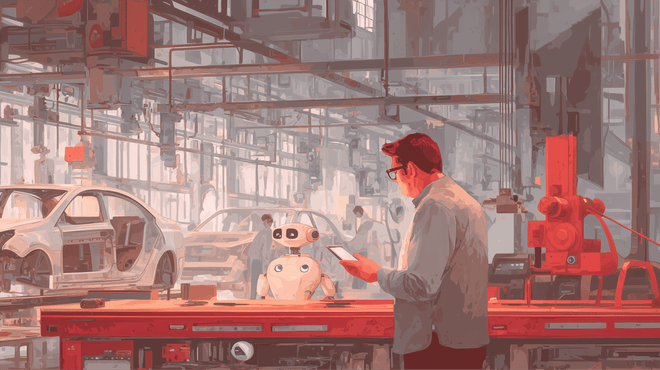In the time it takes you to read this intro, 5.48 European businesses have adopted AI. In fact, AI is spreading faster than mobile phones did in their first decade on the market. What once took years to become standard now happens in months, as automation, data analytics, and decision-support tools move from experiments to daily use.
So what is really happening with AI today? How many companies are only experimenting, and how many are getting measurable results? Is it too late for a business to invest and catch up, or is the window still open for strategic action?
We gathered the latest statistics and reports from McKinsey, Deloitte, PwC, IBM, and other trusted researchers. These insights show not just how businesses are using AI right now, but also where the market is heading and which directions are worth watching before the next wave begins.
AI market
Let’s check where AI stands in the market today.
The market size in the Artificial Intelligence sector is projected to reach US $254.50 billion in 2025. (With 2025 coming to an end, this figure still stands as an estimate; official end-of-year results are usually released in the first quarter of the following year. We’re waiting for updates.)
Looking further ahead, the market is expected to grow at an annual rate of 36.89% between 2025 and 2031, reaching about US $1.68 trillion by the end of the period.
The United States continues to hold the largest share, estimated at US $46.99 billion in 2025.
According to the United Nations’ development agency, the global AI market could hit US $4.8 trillion by 2033, becoming one of the defining frontier technologies of the next decade.
A major driver of this expansion is generative AI, which has transformed how enterprises adopt and use intelligent systems.
The generative AI market alone is projected to reach US $59.01 billion in 2025 and grow to US $400 billion by 2031, with an expected annual growth rate of 37.57%.
McKinsey estimates that generative AI could unlock between US $2.6 trillion and US $4.4 trillion in additional value, on top of what traditional analytical AI already brings to businesses.
The U.S. still leads on building top AI models, though observers note China is narrowing the performance gap.
AI adoption and usage
If market numbers show the scale of the industry, adoption data reveals how businesses actually behave.
AI use keeps climbing. According to a recent McKinsey survey, 78% of organizations report using AI in at least one business function – up from 72% earlier in 2024 and 55% a year before.
According to Amazon Web Services, one new company in the UK adopts AI every 60 seconds.
In early 2024, 65% of companies reported using gen AI in their workflows; by mid-year, that share had risen to 71%.
A Mercer study found that 54% of business leaders believe their companies will not remain competitive beyond 2030 without adopting AI at scale.
Usage is also spreading among employees. In 2025, 27% of white-collar workers said they frequently use AI in their daily work, a 12-point increase from 2024. Among leadership, the number is higher: 33% of managers and executives use AI tools often, compared to 16% of individual employees.
McKinsey’s data also confirms that C-level leaders remain the most active AI users inside organizations.
The reasons for adoption vary. Most respondents report using AI in IT, marketing, and sales, followed by service operations. The sharpest growth was recorded in IT, where the share of companies applying AI rose from 27% to 36% within just six months.
63% of organizations using generative AI apply it to create text, though many are expanding into image generation and computer code development.
Employees using AI chatbots most often rely on them for research (57%), editing written content (52%), and drafting new materials (47%).
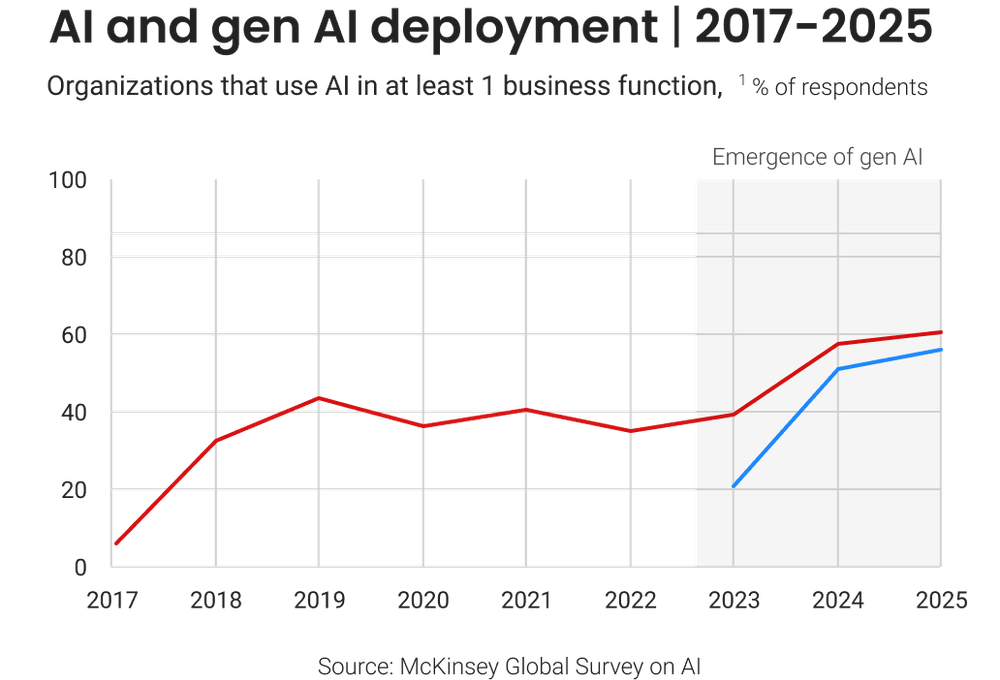
AI business impact
What are businesses actually getting from AI? Let’s see.
According to IBM research, 29% of IT professionals worldwide say AI tools already save employees time by automating routine tasks.
Industries that have embraced AI are now seeing labor productivity grow 4.8 times faster than the global average.
Revenue per employee is also rising. Sectors with high AI exposure show x3 times higher revenue growth per worker compared to those that have been slower to adopt.
53% of small business owners report noticeable improvements in customer experience after implementing AI solutions.
As adoption expands, the impact is spreading across all business departments. BCG’s data shows that support functions like customer service currently generate 38% of AI’s total business value. Still, the strongest potential sits within operations (23%), marketing and sales (20%), and R&D (13%).
Let’s zoom in on generative AI, the most discussed branch of the technology. Early adopters are already seeing returns: an average 12% ROI for companies that integrated gen AI into their workflows.
For content marketing teams, the time savings reach around 11.4 hours per week per employee, freeing capacity for strategic and creative work.
21% of organizations using gen AI have already redesigned some workflows from the ground up. Compared with early 2024, a larger share of companies now report revenue growth directly linked to gen AI initiatives. More respondents also report meaningful cost reductions within units deploying gen AI.
AI for industries
Learning and development (L&D)
AI is steadily reshaping how people learn, teach, and develop new skills.
The AI in education market reached $5.47 billion in 2024 and is projected to grow to $29.89 billion by 2029, with 41.2% annual growth rate.
In 2024, research found that AI-based learning programs increased knowledge retention by 25%.
Adoption among educators and learners is already widespread. A Microsoft survey across schools and universities found the following:
- 47% of education leaders use AI daily,
- 68% of teachers have tried it several times,
- 62% of students have used it at least occasionally.
Teachers rely on AI for research (44%), lesson planning (38%), summarizing materials (38%), and creating tests and assignments (37%).
Automation’s potential is huge. McKinsey estimates that automating educational content creation alone could save around $60 billion globally.
In the corporate world, expectations are equally high. According to Harvard Business Impact’s 2025 Global Leadership Development Study, 49% of L&D leaders believe AI will improve talent development outcomes. Half of them expect it to enhance the scalability of learning programs, and 53% believe it will make training more adaptable to individual needs.
Yet, challenges remain. Only 36% of L&D organizations say their leaders fully recognize the importance of making AI a central part of business strategy, and just 42% report strong support for employee experimentation with AI tools.
Retail and eCommerce
The global AI in retail market, valued at $9.36 billion in 2024, is expected to skyrocket to $85.07 billion by 2032 – an annual growth rate of nearly 32%.
The AI-powered eCommerce market follows a similar path, projected to hit $16.9 billion by 2030.
Around 42% of retailers, surveyed by NVIDIA, are actively using AI, while another 34% are testing or planning to deploy it soon.
Larger retailers, especially those earning over $500 million annually, are leading the charge. Among them, 64% have already adopted AI – far above the industry average – and another 22% are exploring how to apply it further. Only 7% remain unaware of AI tools that could support their business.
Adoption also runs deep. Of those already using AI, over 80% said they’ve implemented three or more use cases, and more than half reported six or more in production. The breakdown shows how far experimentation has gone:
- 1–2 use cases: 16%
- 3–5 use cases: 30%
- 6+ use cases: 54%
69% of retailers using AI say it has already helped grow their revenue. Nearly a third report gains between 5% and 15%, while 15% saw increases above 15%.
With numbers like these, it’s no surprise that over 60% of retail leaders plan to boost their AI investment in the next year and a half.
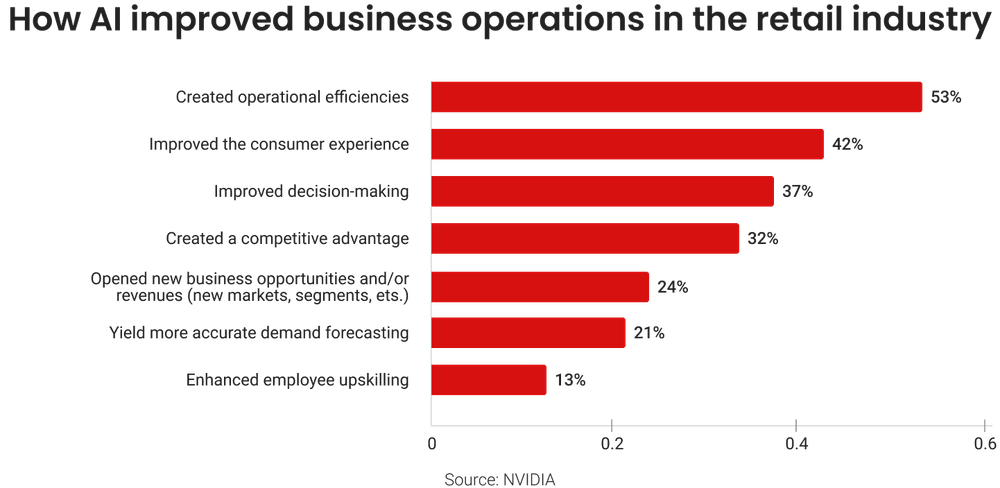
Veterinary
In veterinary medicine, conversations about AI are already happening in clinics, labs, and hospitals across the U.S.
According to the American Animal Hospital Association, more than 83% of veterinary professionals are familiar with AI tools.
Awareness alone wouldn’t mean much if it didn’t translate into real use, but it does. About 39% of veterinarians have already adopted AI in their daily work, and among them, nearly 70% rely on it every day or every week.
The same research found a strong link between familiarity and acceptance: over 65% of those who understand how AI works are open to using it more broadly.
Resistance remains low: only 15.5% of respondents said they were reluctant to use AI. While nearly 39% expressed interest in introducing it into their workflows.
Healthcare
The AI in healthcare market is projected to reach US $868 billion by 2030, generating about US $646 billion in cost savings and US $222 billion in new revenue.
Adoption of AI tools is already widespread. A recent survey found that 85% of healthcare leaders, including payers, health systems, and technology providers, are either experimenting with or have already deployed generative AI.
Most early adopters use gen AI for the following critical areas:
- Administrative efficiency (75%),
- Clinical productivity (74%)
- Patient or member engagement (55%)
- IT or infrastructure (55%)
- Quality of care (41%)
- Research and education (41%)
- Strategy and growth (25%)
There are some local studies that support AI’s positive impact. In Yorkshire, England, an AI model correctly predicted hospital transfers in 80% of cases.
Another research used AI to detect skin cancer. It showed that AI technology had a 100% detection rate for melanoma and was 99.5% accurate in detecting all skin cancers.
Among organizations already applying generative AI, 64% report positive or expected returns on investment.
The World Economic Forum estimates that 4.5 billion people currently lack access to essential healthcare services, while a shortage of 11 million healthcare workers is expected by 2030. And they believe AI will close this gap.
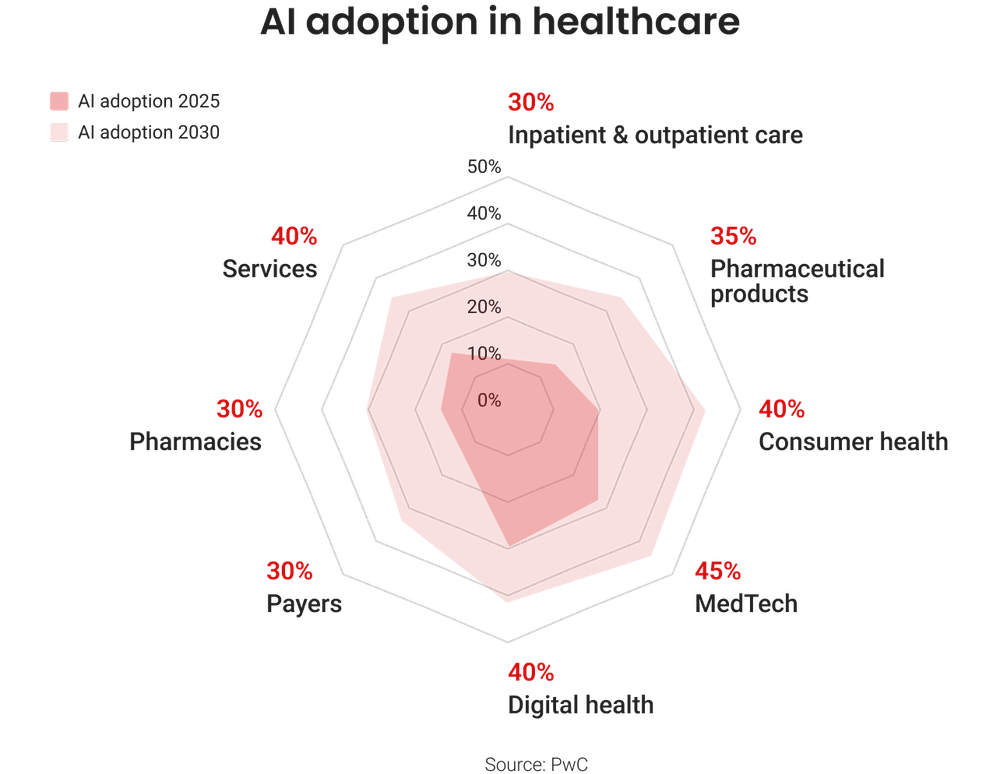
Legal
In 2025, 31% of individual legal professionals reported using generative AI at work – up from 27% in 2024.
Firm size also makes a difference. Larger firms, those with 51 or more lawyers, show much stronger adoption rates – 39% are already using generative AI in some capacity.
Smaller practices, with 50 or fewer lawyers, report roughly 20%, about half as much.
Interestingly, lawyers are not just using AI for case preparation or research anymore. 54% now rely on it to draft correspondence, while 14% use it to analyze firm data and case patterns.
Nearly half (47%) are eager to apply AI for financial insights and business management.
In one example, a high-volume litigation team used an AI-powered complaint response system that cut the drafting time from 16 hours to just 3–4 minutes. The efficiency boost was over 100 times.
Manufacturing
The global AI in manufacturing market is expected to rise from $7.6 billion in 2025 to $62.33 billion by 2032, growing at a strong 35.1% CAGR.
In this race, Asia Pacific leads the pack, holding nearly 41.8% of the global share in 2024.
Across Europe, AI adoption is also rising. In 2025, 51% of manufacturers, surveyed by the National Association of Manufacturers (NAM) reported using AI in some form.
As for the tasks, Eurostat claims that AI is most often applied in marketing and sales (27.11%) and production processes (26.23%)
According to McKinsey, manufacturers that apply machine learning are 3 times more likely to improve their key performance indicators.
About 72% of surveyed manufacturers report reduced costs and improved operational efficiency after introducing AI tools.
PwC states that 98% of industrial companies expect digital technologies, including AI, to increase operational efficiency.

Transportation and logistics
In 2024, the global AI in logistics market was valued at $17.96 billion. By 2025, it’s expected to reach $26.35 billion, and then accelerate dramatically to around $707.75 billion by 2034, growing at a 44.4% CAGR.
McKinsey’s data shows why companies are racing to adopt it. AI-driven automation is already helping businesses:
- Cut inventory by 20–30%
- Lower logistics costs by 5–20%,
- Save 5–15% in procurement spend.
Almost 95% of distributors say they’re exploring AI use cases across their operations, from forecasting to delivery optimization. But the challenge isn’t interest; it’s readiness. Only 30% believe they have enough skilled talent to scale AI projects, and fewer than 10% have a clear roadmap with prioritized use cases.
Inside warehouses, AI is also bringing some benefits. Smart analytics can uncover 7–15% additional capacity in existing facilities by detecting unused space, adjusting workflows, and balancing workloads more efficiently.
Looking ahead, experts suggest that by 2035, AI adoption could lift productivity in developed economies by over 40%, fueled largely by logistics and supply chain operations.
AI in departments
Let’s take a look at how AI is being used across different departments inside organizations.
In marketing and sales, adoption remains the most active. McKinsey reports that about 20% of sales activities could already be automated using current AI tools.
McKinsey also estimates that AI can reduce HR costs by 15–20% by revealing the main factors behind employee attraction, turnover, and performance – and suggesting ways to improve them.
Research and development also benefits from AI, with estimates showing that it could accelerate R&D work by 20% to 80%, depending on the sector.
When it comes to customer experience, the trend is clear. A Salesforce survey found that 63% of service professionals believe generative AI helps them work faster.
Gartner expects that by 2025, 80% of support organizations will apply AI in some form to improve agent productivity and customer satisfaction.
IBM adds that analyzing calls, emails, and tickets with AI helps companies improve responses and reduce costs by 23.5%.
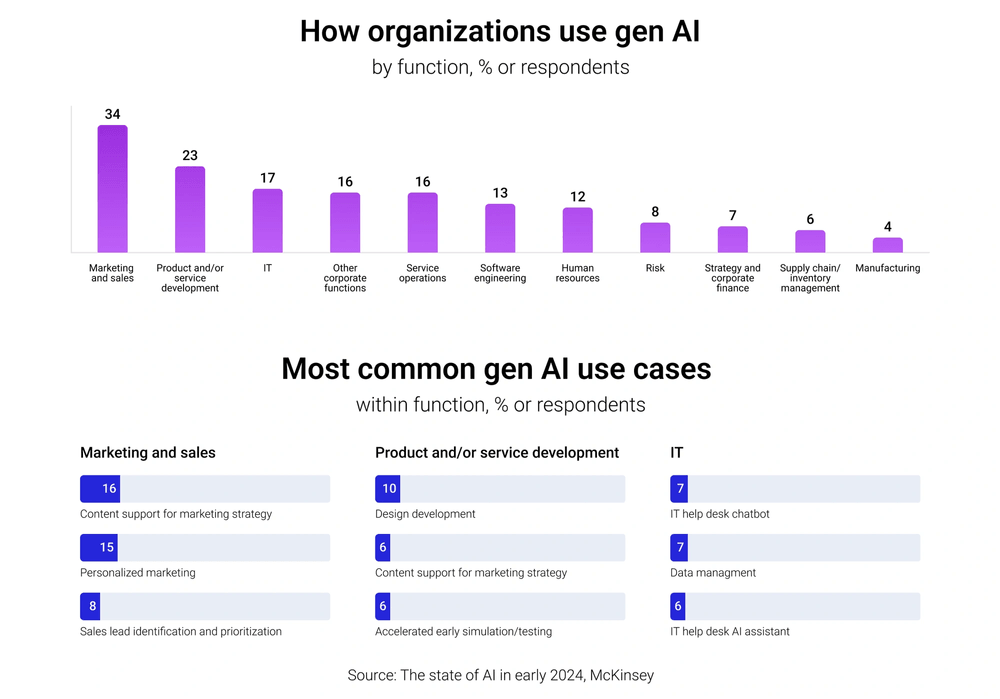
AI challenges
While AI adoption continues to grow, many organizations still face structural and technical barriers that slow down progress.
According to IBM, the top concerns for 2025 include:
- Data accuracy and bias (45%),
- Limited proprietary data to train models (42%),
- A lack of generative AI expertise (42%),
- Inadequate financial justification or business case (42%),
- Data privacy (40%).
However, many companies are already taking practical steps to overcome these challenges:
- 80% of organizations have created dedicated functions to oversee AI-related risks;
- 81% conduct regular risk assessments to identify potential security threats;
- 78% maintain clear documentation on how generative models are trained;
- 76% have established governance structures and policies to guide AI use;
- 72% have formal procedures for handling data and addressing emerging risks.
Nearly 60% of AI leaders surveyed by Deloitte pointed to legacy systems and compliance issues as the main barriers to adopting agentic AI.
For physical AI, such as robots, autonomous vehicles, digital twins, and connected medical devices, the list of challenges looks slightly different. The leaders chose the following obstacles:
- Infrastructure integration (35%)
- Workforce skill/readiness (26%)
- Investment/operational costs (21%)
- Safety and security concerns (5%).
Another emerging topic is sovereign AI, which focuses on keeping data, models, and computational resources within defined regional or organizational boundaries.
More than 50% surveyed AI leaders said that monitoring regulations and maintaining infrastructure control are the biggest challenges in this area.
At the employee level, challenges also persist. About 66% of workers admit to using AI outputs without verifying their accuracy, and 56% say they have made mistakes at work because of AI.
Only 27% of organizations review all AI-generated content before use, while a similar share checks less than 20% of it.
At the same time, according to McKinsey, organisations report greater attention to specific gen-AI risks. Compared with early 2024, more respondents now say their companies are actively managing risks related to inaccuracy, cybersecurity, and intellectual-property infringement – the three gen-AI risks most often linked to negative outcomes.

AI investments
Private investment in AI reached about $252 billion worldwide in 2024.
Within that, $33.9 billion went to generative AI – almost 19% more than in 2023. Corporate mergers and acquisitions in the AI space also rose by about 12%.
The United States continued to dominate funding, attracting $109.1 billion in private AI investment – roughly twelve times more than China’s $9.3 billion, and twenty-four times more than the United Kingdom’s $4.5 billion.
According to IBM, the number of newly funded generative AI startups nearly tripled since 2024, and overall business adoption moved from pilot projects to everyday use.
McKinsey’s 2025 survey shows that 92% of firms plan to increase their AI budgets within the next three years.
According to Accenture, 69% of leaders believe AI demands a full rethink of how their systems and processes are built and managed.
AI trends and predictions
Stanford researchers call AI one of the most transformative forces of the 21st century.
One of the AI areas gaining major attention is agentic AI – systems capable of taking autonomous actions to achieve defined goals.
Job postings mentioning this field grew by 985% between 2023 and 2024, showing how quickly companies are exploring its capabilities.
Another visible shift is happening in hardware. The growing demand for computing power has driven innovation in application-specific semiconductors, designed to handle AI workloads more efficiently.
In terms of industries, several trends stand out. Some research agencies claim AI use in healthcare continues to rapidly expand. Businesses also are more often refining customer service with AI-driven chatbots and virtual assistants
Globally, optimism about AI is growing, though unevenly. In China (83%), Indonesia (80%), and Thailand (77%), most people view AI as more helpful than harmful.
Yet in Canada (40%), the United States (39%), and the Netherlands (36%), confidence remains modest.
However, on average, only 46% of people worldwide say they trust AI systems.
Bottom line
When it comes to what to expect in the future, researchers hesitate to make bold predictions. The field moves too fast. What seems advanced today may become outdated within months. That’s why forecasts about where AI will be in five years are cautious and often wrong within two.
What can be said with certainty is that the interest and investment in AI kept growing throughout 2025 and show no signs of slowing in 2026. Companies continue experimenting, building, and improving, and AI is becoming a standard part of business infrastructure.
Still, thinking about AI and implementing it are two very different things. The gap between idea and execution is where most projects stall. That’s why professional guidance is essential.
If you are just starting to explore how AI could work for your company, we can help you make that first step confidently and correctly.
At Aristek, our AI experts focus on what works in practice. We don’t suggest adding AI just because it looks good in a marketing pitch; we help determine where it can genuinely improve your processes, automate routine operations, or enhance decision-making accuracy.






